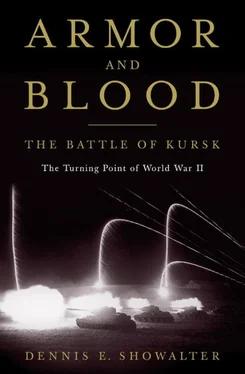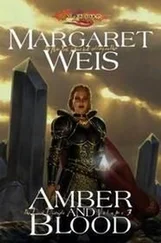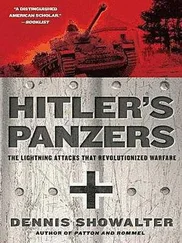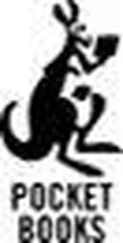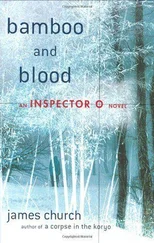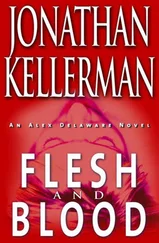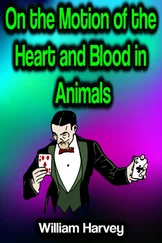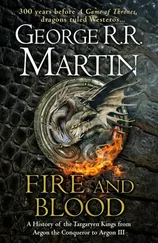Dennis E. Showalter
ARMOR AND BLOOD
The Battle of Kursk: The Turning Point of World War II

THE BATTLE OF KURSK is a continuing paradox. On the one hand, it is regularly described as a military epic: history’s greatest armored battle, the first stage on the Red Army’s road to Berlin, an ultimate test of Nazi and Soviet military/political systems. On the other, it is strangely blurred. Compared with Stalingrad or Barbarossa, it remains obscure, its narrative fostering myth as much as history. In the context of Western, particularly English-language, writing on World War II, Kursk is part of an imbalance that focuses on Anglo-American operations. The sheer scale of the fighting, the absence of significant cultural and political reference points, and an understandable interest in the deeds of one’s own countries combine in a literature acknowledging the Russo-German War after Stalingrad as a vital factor in the war’s development and outcome but restricting it to the periphery in terms of page counts.
A recent development in the historiography of the Russo-German War integrates it into the related perspectives of total war and genocide. Sometimes it becomes pivotal, as in Niall Ferguson’s The War of the World and in Timothy Snyder’s Bloodlands . In other works, such as Stephen Fritz’s Ostkrieg or Catherine Merridale’s Ivan’s War , Kursk, when it appears, becomes a footnote in a wider story of Armageddon and apocalypse.
In the context of the Russo-German War as a subject of military analysis, Kursk remains blended with what Germany’s Military History Research Institute, the Militärgeschichtliches Forschungsamt, calls the “forgotten year” (from summer 1943 to summer 1944), a time of inglorious retreats on the German side and inglorious victories for the Soviets—both achieved at excessive cost and neither offering much inspiration or value to students of the art/science/craft of war. In that sense, Kursk becomes a counterpoint to Passchendaele and Chemin des Dames in World War I, or the American Civil War’s Wilderness: a tribute to uninspired hard fighting and colossal human suffering.
Well before John Keegan’s The Face of Battle focused military writers’ attention away from the map movements of abstract red and blue blocks to the mechanics of battle as they apply to men at the sharp end, Kursk generated accounts of memory and explanation. Two master narratives emerged. The German version depicted a heroic struggle, wearing down massively superior Soviet defenders, climaxing with the SS Panzer Corps’s destruction of the Fifth Guards Tank Army at Prokhorovka—only to have their victory thwarted by Hitler’s micromanaging and indecision. The Soviet counterpart depicted a German attack first ground down by a scientifically created, dauntlessly defended fortification system, then defeated by the intrepid attack of the Fifth Guards Tank Army at Prokhorovka.
Addressing the contradictions between the two memes has been complicated until recently by a virtual German monopoly of Eastern Front narratives. The USSR’s determination to control the story of the Great Fatherland Patriotic War was complemented by a discouraging of memory and memoir at every rank from private to marshal of the Soviet Union. The improved post-Soviet access to archives, memories, and battlefields has combined with postreunification developments in German military historiography to revitalize, indeed revolutionize, the academic and general-audience writing on Kursk and its matrices.
The general intention of this book is to synthesize the material and the perspectives that have in some cases been upheld and in others modified, reshaped, or revised. It is operationally structured, but not operationally focused. The events of the battle are used to contextualize wider issues of operations and strategy, institutional structure and state policy, and to convey some of the Eastern Front’s human dimension.
This work has a specific purpose as well: to structure and clarify the newly available mass of detail, official, tactical, and personal, on the fighting. Kursk was a battle before it became anything else. That makes it worthwhile knowing who did what, where, when, with what, to whom, and above all why . This requires collating, comparing, and critiquing official and personal accounts, contextualizing them in a geography significantly unfamiliar to all but a few potential readers, then presenting the results in a way that is comprehensible without being condescending.
For the sake of clarity, the text uses Russian orthography for geographic features. It addresses the two-hour difference between German and Russian official time by citing the time noted by the subjects of the narrative: German when the actors are German, Russian for Russian. The text also minimizes references to the obscure villages and low heights that were the usual foci of orders and reports and challenge the most detailed and costly tactical maps. In each case of this kind of judgment call, the author acknowledges any misjudgments and requests charity.
For the sake of another kind of clarity, the linguistically and orthographically complex ranks of the Waffen SS have been translated into their U.S. Army counterparts.
The same acknowledgment and the same request apply to the book’s subtext. That is, to avoid “war porn,” whether in contexts of heroism, pathos, horror, or voyeurism. Should it succeed in nothing else, may that objective stand.
ORDER OF BATTLE, OPERATION CITADEL
GERMAN
ARMY GROUP CENTER—
FIELD MARSHAL GÜNTHER VON KLUGE
9th Army—General Walter Model
XX Corps
45th, 72nd, 137th, 251st Infantry Divisions
XLVI Panzer Corps
7th, 31st, 102nd, 258th Infantry Divisions
XLVI Panzer Corps
2nd, 9th, 20th Panzer Divisions, 6th Infantry Division
XLI Panzer Corps
18th Panzer Division, 86th, 292nd Infantry Divisions
XXIII Corps
78th Assault Division, 36th, 216th, 383rd Infantry Divisions
ARMY GROUP SOUTH—FIELD MARSHAL ERICH VON MANSTEIN
4th Panzer Army General Hermann Hoth
XLVIII Panzer Corps
3rd, 11th Panzer Divisions, Panzer Grenadier Division Grossdeutschland, 167th Infantry Division
II SS Panzer Corps
SS Panzer Grenadier Divisions Leibstandarte, Das Reich, Totenkopf
LII Corps
57th, 255th, 332nd Infantry Divisions
ARMY DETACHMENT KEMPF— GENERAL WERNER KEMPF
III Panzer Corps
6th, 7th, 19th Panzer Divisions
XI Corps
106th, 320th Infantry Divisions
XLII Corps
39th, 161st, 282nd Infantry Divisions
RUSSIAN
CENTRAL FRONT—GENERAL KONSTANTIN ROKOSSOVSKY
13th, 48th, 60th, 65th, 70th Armies, 2nd Tank Army, 9th, 19th Tank Corps
VORONEZH FRONT—GENERAL NIKOLAI VATUTIN
6th, 7th Guards Armies, 38th, 40th, 69th Armies, 1st Tank
Army, 35th Guards Rifle Corps, 2nd, 5th Guards Tank Corps
5th Guards Army, 5th Guards Tank Army assigned from Steppe
Front during Citadel as reinforcements
Chapter I

GENESIS
“IT’S TIME TO WRITE THE LAST WILL:” one SS trooper grimly noted in his diary on July 5, 1943, while awaiting the order to advance. Across the line, Soviet soldiers swapped their own grim jokes—like the one about the tanker who reported that almost everyone in his unit had been killed that day. “I’m sorry,” he replied, “I’ll make sure I burn tomorrow.”
Читать дальше
